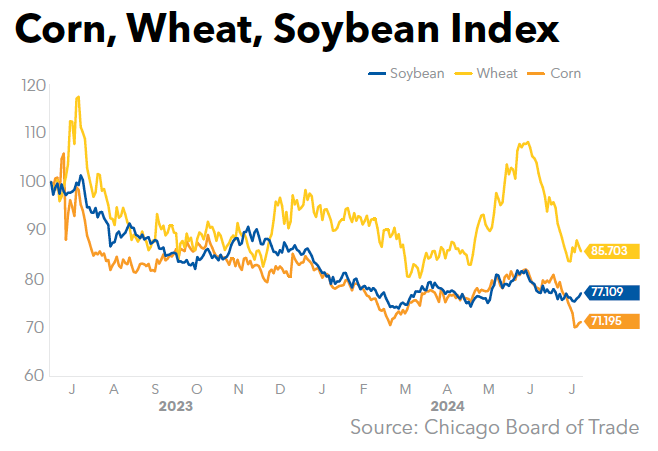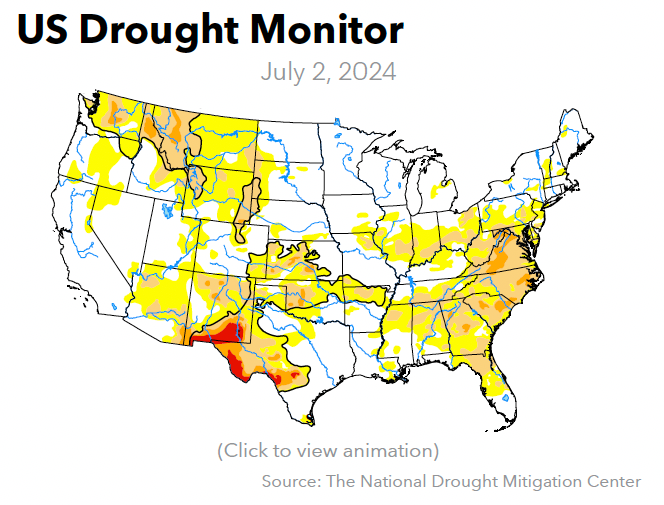Eastern Cornbelt:
Thunderstorms rolled through northern Illinois at midweek, with spotty showers also reported across central Illinois. Hotter weather was on the way, however, with highs in Illinois expected to climb to the 90s for the balance of the week.
After strong thunderstorms pounded central Indiana over the prior weekend, heat and humidity returned to the state during the first days of July, with highs expected to hit the mid-80s and high humidity pushing readings into the 90s.
Thunderstorms also pushed through northern Ohio at midweek, with temperatures topping out in the 80s and additional rains expected for the balance of the week.
Good or excellent ratings were assigned to 65-66% of the corn and 63-64% of the soybeans in Illinois, Indiana, and Ohio on June 30. Michigan’s corn crop was rated as 73% good or excellent, while soybeans in those two categories totaled 59% of the acreage in the state.
Western Cornbelt:
Tornado warnings and watches were in effect for multiple counties in eastern Iowa on July 2, while torrential rain hit parts of central Iowa on that date, causing flooding in some locations. Rainfall totals included 5.5 inches in Indianola, 4.96 inches in Greenfield, and 3.82 inches in Pella.
The same system produced tornadoes and heavy rain in parts of western Nebraska as well, with reports of flooding in Lincoln at midweek. Missouri was bracing for high heat and potentially strong thunderstorms as the week progressed, with heat advisories in effect for southern areas of the state.
Crop conditions were favorable across the region, with 73-80% of the corn and 72-78% of the soybeans rated as good or excellent on June 30. Good or excellent ratings were also assigned to 60% of Missouri’s cotton and 79% of the state’s rice crop, while 84% of Nebraska’s sorghum crop was rated as good or excellent at the end of June.
California:
Excessive heat warnings were in effect across California during the week, with highs reaching 122 degrees in Death Valley on July 3. Northern California and the Central Valley were also sweltering, with highs in Sacramento expected to range from 105-115 degrees as the week progressed.
The heatwave contributed to a wildfire in Butte County that forced the evacuation of about 13,000 people in and around Oroville at midweek. The blaze, dubbed the Thompson Fire, grew to more than three square miles in one day with zero containment.
Pacific Northwest:

Oregon was bracing for sweltering temperatures over the coming weekend, prompting excessive heat warnings for multiple counties, with highs expected to reach 100-110 degrees on July 6-10. Heat warnings were also issued for western Washington, where weekend forecasts warned of temperatures in the 90s.
The heat wave was also expected to impact southern Idaho on July 6-10, with highs expected to reach the low triple digits, roughly 20 degrees above normal. Temperatures in Montana were expected to climb to the 80s, but much of the state enjoyed cool, rainy weather in the days leading up to July 4.
Crops in the region were generally described as favorable in early July. Good or excellent ratings were assigned to 73-84% of Idaho’s wheat and barley crops, compared with 67% in Oregon, 51-60% in Montana, and 48-55% in Washington.
Western Canada:
Cool, wet weather was reported across much of Western Canada during the first week of July as thunderstorm risks persisted across the region. Forecasts warned of potentially severe storms along the Saskatchewan and Manitoba border later in the week, including the threat of large hail and spotty downpours.
Crops were generally favorable in the region, though the weather has slowed development in some areas.
“Cooler temperatures continue to slow crop development,” the latest Saskatchewan Crop Report said. “Spring wheat and oilseed crops are still the furthest behind the normal stages of development for this time of year…(and) warmer temperatures are needed to help crop development progress.”
